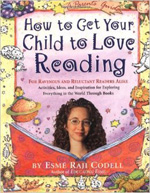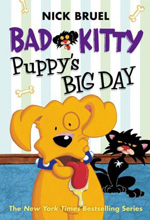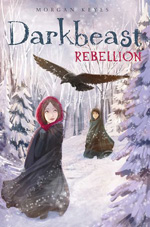Despite the ubiquity of the Common Core State Standards and high-stakes test preparation, effective teachers know it’s important to make time for shared reading in the classroom. There are many wonderful titles to share with students (so many, in fact, that we’ll be running a second installment next week!), who can use them to model their own thinking and enjoyment of the books, and building community since the class is often held spellbound, enraptured by the sound of well-chosen words, and curious about what will happen next. This week’s book reviews from the Children’s Literature and Reading Special Interest Group focus on some marvelous read alouds and advice on reading aloud to youngsters.
Codell, Esme Raji. (2003). How to Get Your Child to Love Reading. New York, NY: Algonquin Books.
 The author’s enthusiasm for all things book-related does not go unremarked in this comprehensive compendium of awesome ideas to get youngsters excited about reading. Not only does she provide various books lists, some related to assorted content or subject areas, but she also offers ideas for birthday parties based on books, book parades, book festivals, radio broadcasts, and reader’s theater, all designed to get reluctant readers reading. While the lists are a bit dated and could use some updating with recent publications, parents and teachers will find plenty of helpful suggestions and support in this sizeable resource. It’s hard to resist the author’s zest for the printed word and all the pleasures it brings to life.
The author’s enthusiasm for all things book-related does not go unremarked in this comprehensive compendium of awesome ideas to get youngsters excited about reading. Not only does she provide various books lists, some related to assorted content or subject areas, but she also offers ideas for birthday parties based on books, book parades, book festivals, radio broadcasts, and reader’s theater, all designed to get reluctant readers reading. While the lists are a bit dated and could use some updating with recent publications, parents and teachers will find plenty of helpful suggestions and support in this sizeable resource. It’s hard to resist the author’s zest for the printed word and all the pleasures it brings to life.
Ages 4-8
Bruel, Nick. (2015). Bad Kitty: Puppy’s Big Day. New York, NY: Roaring Brook Press.
 Even on a good day, Bad Kitty is rarely the most tolerant of felines. But for reasons unknown to those around her, on this particular day, a very, very, very bad day, she wreaks havoc in her home and sends poor Puppy cowering behind the furniture. While her human companions try to console Kitty, Uncle Murray is enlisted to walk Puppy. Their trip is not without its challenges. Even though he's glad to spend time with the friendly dog, Uncle Murray receives citations for various offenses, including not having her on a leash, not picking up after her, and not having a license. An encounter with a bulldog results in both dogs being put in the city pound. When Uncle Murray arrives to claim Puppy, he is unable to resist those pleading eyes and leaves with more than Puppy. It’s fun to read the story in all those animal voices. Once they arrive home, the reason for Bad Kitty's terrible mood will be made clear. Readers will adore Puppy's unflappable nature and sweet-natured Uncle Murray. Many cat-loving readers will recognize their own felines in Bad Kitty who, when she is good, she is very, very good, and when she is horrid ... well, you’d better look out.
Even on a good day, Bad Kitty is rarely the most tolerant of felines. But for reasons unknown to those around her, on this particular day, a very, very, very bad day, she wreaks havoc in her home and sends poor Puppy cowering behind the furniture. While her human companions try to console Kitty, Uncle Murray is enlisted to walk Puppy. Their trip is not without its challenges. Even though he's glad to spend time with the friendly dog, Uncle Murray receives citations for various offenses, including not having her on a leash, not picking up after her, and not having a license. An encounter with a bulldog results in both dogs being put in the city pound. When Uncle Murray arrives to claim Puppy, he is unable to resist those pleading eyes and leaves with more than Puppy. It’s fun to read the story in all those animal voices. Once they arrive home, the reason for Bad Kitty's terrible mood will be made clear. Readers will adore Puppy's unflappable nature and sweet-natured Uncle Murray. Many cat-loving readers will recognize their own felines in Bad Kitty who, when she is good, she is very, very good, and when she is horrid ... well, you’d better look out.
Mader, C. Roger. (2014). Tiptop Cat. New York, NY: Houghton Mifflin Harcourt Books for Young Readers.
 When a handsome black and white tuxedo cat comes into the life of a Parisian family, he is pampered and treated just the way one might expect a favorite present to be treated. Allowed to rule the roost in his home on the sixth floor of a Parisian apartment, he longs to go higher, ever higher. As cats will do, his exploration of his domain leads him to the apartment’s balcony, a perch which allows him to leap to the rooftop and survey the city. When he somehow survives a fall from the balcony while leaping into midair after a pigeon, he returns home a bit sheepish and fearful. Eventually, this feline with a need for lofty spaces slips out to the balcony once more and scampers onto the rooftop. The story’s reminder not to allow fear to keep readers from doing what they want to do is a bit heavy-handed, but it’s hard to resist the cat’s irrepressibly curious and determined nature. Readers will be enraptured by the stunning pastel illustrations that capture the cat's personality and the beauty of Paris, a visual feast spread out at his feet.
When a handsome black and white tuxedo cat comes into the life of a Parisian family, he is pampered and treated just the way one might expect a favorite present to be treated. Allowed to rule the roost in his home on the sixth floor of a Parisian apartment, he longs to go higher, ever higher. As cats will do, his exploration of his domain leads him to the apartment’s balcony, a perch which allows him to leap to the rooftop and survey the city. When he somehow survives a fall from the balcony while leaping into midair after a pigeon, he returns home a bit sheepish and fearful. Eventually, this feline with a need for lofty spaces slips out to the balcony once more and scampers onto the rooftop. The story’s reminder not to allow fear to keep readers from doing what they want to do is a bit heavy-handed, but it’s hard to resist the cat’s irrepressibly curious and determined nature. Readers will be enraptured by the stunning pastel illustrations that capture the cat's personality and the beauty of Paris, a visual feast spread out at his feet.
Ages 9-11
Danneberg, Julie. (2015). John Muir Wrestles a Waterfall. Watertown, MA: Charlesbridge.
 For readers unfamiliar with conservationist John Muir's love for the wilderness, especially the Yosemite area, this slice of his life’s story may entice them to read more. Muir seemed to need to get as close to nature as possible, and this picture book recounts how that inclination almost cost him his life. Drawing from an essay about the incident that was published in 1890 and 1912, the author describes how the conservationist left his cabin near Yosemite Falls with its 2,425-foot drop, walked up a trail, and then slipped behind the falls when the wind moved the water just enough for him to do so. Enchanted by the majesty of the water, Muir relished this first-hand experience directly beneath the falls. But when the wind blew the water against him again in its natural pattern, he was barely able to hold on. Eventually, he made his way out from under the water, but fully aware of how close he came to death and mindful of nature's savage majesty. The handsome illustrations, created with Prismacolor and pastel pencils, pay tribute to this determined man and the wild world that tempted him to take risks. Although the book celebrates nature's beauty, it is also a cautionary tale, and a firm reminder that some things are meant to be appreciated from a distance.
For readers unfamiliar with conservationist John Muir's love for the wilderness, especially the Yosemite area, this slice of his life’s story may entice them to read more. Muir seemed to need to get as close to nature as possible, and this picture book recounts how that inclination almost cost him his life. Drawing from an essay about the incident that was published in 1890 and 1912, the author describes how the conservationist left his cabin near Yosemite Falls with its 2,425-foot drop, walked up a trail, and then slipped behind the falls when the wind moved the water just enough for him to do so. Enchanted by the majesty of the water, Muir relished this first-hand experience directly beneath the falls. But when the wind blew the water against him again in its natural pattern, he was barely able to hold on. Eventually, he made his way out from under the water, but fully aware of how close he came to death and mindful of nature's savage majesty. The handsome illustrations, created with Prismacolor and pastel pencils, pay tribute to this determined man and the wild world that tempted him to take risks. Although the book celebrates nature's beauty, it is also a cautionary tale, and a firm reminder that some things are meant to be appreciated from a distance.
Lumbard, Alexis York. (2015). Pine and the Winter Sparrow. Illus. by Beatriz Vidal. Bloomington, IN: Wisdom Tales.
 While there are many legends explaining why pine trees retain their greenery during the winter months, this one, attributed to the Cherokees, is satisfying since it also teaches compassion. Grounded with an injured wing, Sparrow cannot migrate as the air turns colder, and his family starts their long journey to warmer climes. Looking for compassion, he seeks shelter from several different trees. Despite their abundant leaves, they all turn him down. Finally, when Sparrow is almost too cold and exhausted to continue, Pine offers a place to stay. The Creator rewards the tree for its generosity to the bird, and proclaims that the pine will remain evergreen. Filled with soft, lovely illustrations, the book strongly exemplifies kindness to others in need, making it an especially appealing read aloud.
While there are many legends explaining why pine trees retain their greenery during the winter months, this one, attributed to the Cherokees, is satisfying since it also teaches compassion. Grounded with an injured wing, Sparrow cannot migrate as the air turns colder, and his family starts their long journey to warmer climes. Looking for compassion, he seeks shelter from several different trees. Despite their abundant leaves, they all turn him down. Finally, when Sparrow is almost too cold and exhausted to continue, Pine offers a place to stay. The Creator rewards the tree for its generosity to the bird, and proclaims that the pine will remain evergreen. Filled with soft, lovely illustrations, the book strongly exemplifies kindness to others in need, making it an especially appealing read aloud.
Ages 12-14
Keyes, Morgan. (2013). Dark Beast Rebellion. New York, NY: Simon & Schuster Books/Margaret A. McElderry Books.
 Picking up right where its predecessor, Darkbeast (Simon & Schuster, 2012), left off, this title follows Keara, her friend Goran, and their mentor Taggart as they seek shelter. Having defied their community’s laws by not killing their darkbeasts once they come of age, they must find someplace where they and their animal companions can be safe. Just when they are ready to give into the fierce coldness around them, they are rescued by what seems to be a friendly band who share their affection for the darkbeasts who serve to soothe their negative emotions. But all is not as it seems, and the little band finds itself betrayed. Still, even amid that treachery, there is hope that arrives from a most unlikely source. Readers will surely enjoy the creation of this world and its characters, especially the imperfect but somehow likeable Keara and her darkbeast Caw and those brave enough to defy tradition.
Picking up right where its predecessor, Darkbeast (Simon & Schuster, 2012), left off, this title follows Keara, her friend Goran, and their mentor Taggart as they seek shelter. Having defied their community’s laws by not killing their darkbeasts once they come of age, they must find someplace where they and their animal companions can be safe. Just when they are ready to give into the fierce coldness around them, they are rescued by what seems to be a friendly band who share their affection for the darkbeasts who serve to soothe their negative emotions. But all is not as it seems, and the little band finds itself betrayed. Still, even amid that treachery, there is hope that arrives from a most unlikely source. Readers will surely enjoy the creation of this world and its characters, especially the imperfect but somehow likeable Keara and her darkbeast Caw and those brave enough to defy tradition.
Ages 15+
Johannsson, J. R. (2015). Cut Me Free. New York, NY: Farrar, Straus, and Giroux.
 Certainly not for the faint-hearted, this book follows 17-year-old Piper after she's escaped from an abusive home life and traveled to Philadelphia. Glimpses of the horrors that she and her younger brother Sam have endured are enough to evoke sympathy from readers since she's clearly lived a hellish life. In order to have some semblance of a regular life, she's convinced that she needs a new identity and hires Cam to create it for her. When she happens to see Sanda, another young girl, in the clutches of an abusive man, Piper decides to save the girl. The two begin a new life and start to heal slowly. Their healing process is interrupted when Piper starts receiving threatening messages and is sure someone is watching her. But despite her best instincts, Piper comes to trust Cam. For someone who provides his particular services to maintain contact with a client seems pretty unlikely, but for some reason, Cam is drawn to Piper. Readers may wonder who has time or the inclination for romance when one's very survival is threatened. Still, there were several well-written passages, and it's dismaying to think that men and women like those described in this book actually live—and practice their cruel deeds—right beneath our noses sometimes. Piper is a gutsy heroine trying to move past the horrors that lie behind her. She can only do so but cutting through those emotional ties that bind her to the past.
Certainly not for the faint-hearted, this book follows 17-year-old Piper after she's escaped from an abusive home life and traveled to Philadelphia. Glimpses of the horrors that she and her younger brother Sam have endured are enough to evoke sympathy from readers since she's clearly lived a hellish life. In order to have some semblance of a regular life, she's convinced that she needs a new identity and hires Cam to create it for her. When she happens to see Sanda, another young girl, in the clutches of an abusive man, Piper decides to save the girl. The two begin a new life and start to heal slowly. Their healing process is interrupted when Piper starts receiving threatening messages and is sure someone is watching her. But despite her best instincts, Piper comes to trust Cam. For someone who provides his particular services to maintain contact with a client seems pretty unlikely, but for some reason, Cam is drawn to Piper. Readers may wonder who has time or the inclination for romance when one's very survival is threatened. Still, there were several well-written passages, and it's dismaying to think that men and women like those described in this book actually live—and practice their cruel deeds—right beneath our noses sometimes. Piper is a gutsy heroine trying to move past the horrors that lie behind her. She can only do so but cutting through those emotional ties that bind her to the past.
Barbara A. Ward teaches graduate and undergraduate courses in literacy at Washington State University, Pullman. She spent 25 years teaching in the public schools of New Orleans where she worked with students at every grade level, from kindergarten through high school as well as several ability levels. She is certified in elementary education, English education, and gifted education. She holds a bachelor's in communications and a master's in English Education from the Univeristy of Tennessee and a Ph.D. in Curriculum and Instruction from the University of New Orleans.
These reviews are submitted by members of the International Reading Association's Children's Literature and Reading Special Interest Group (CL/R SIG)and are published weekly on Literacy Daily.